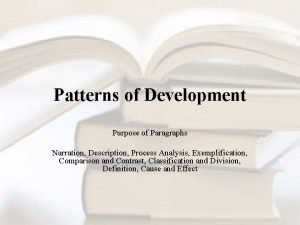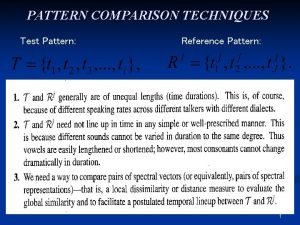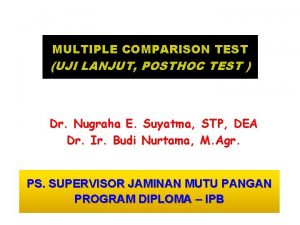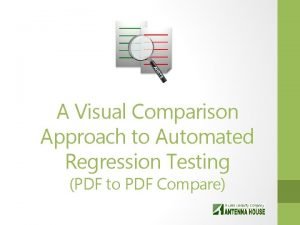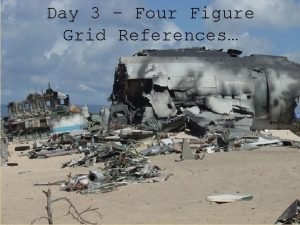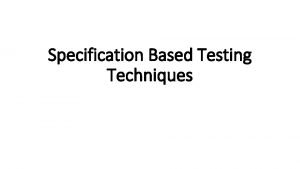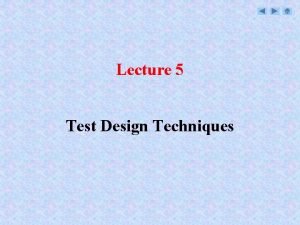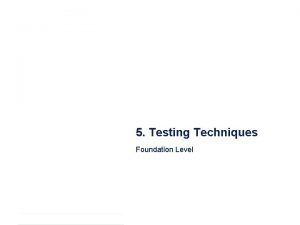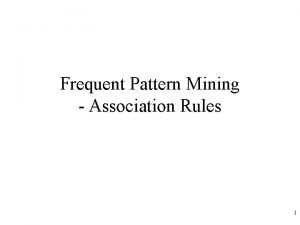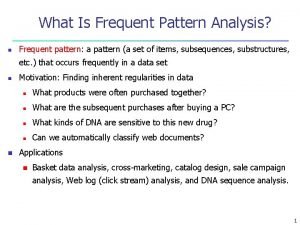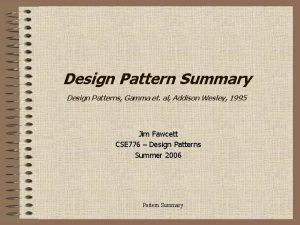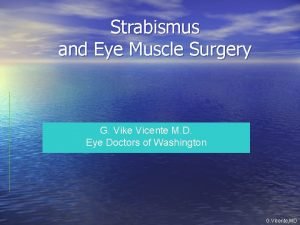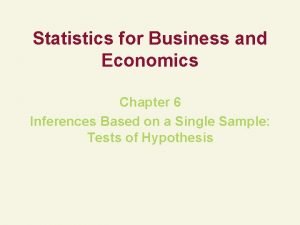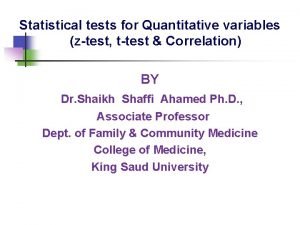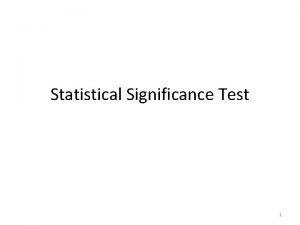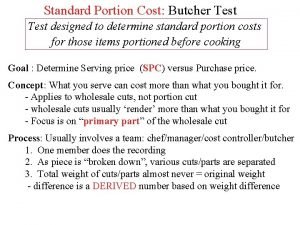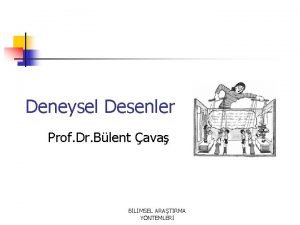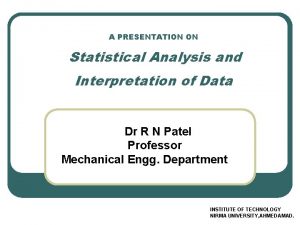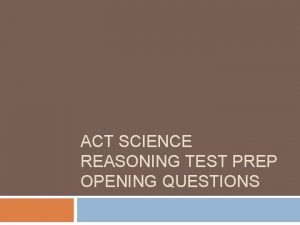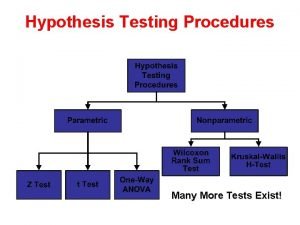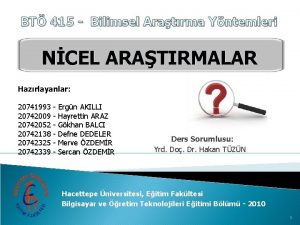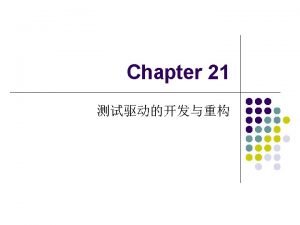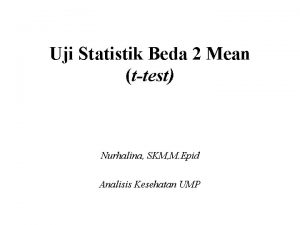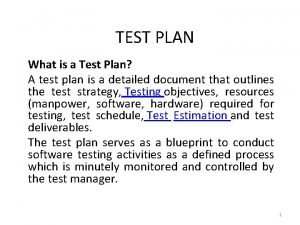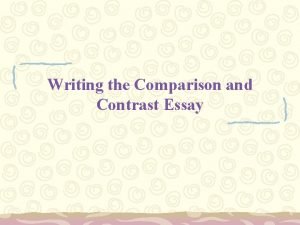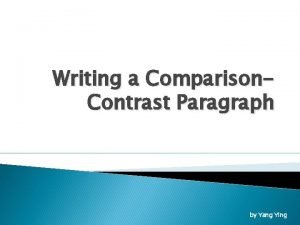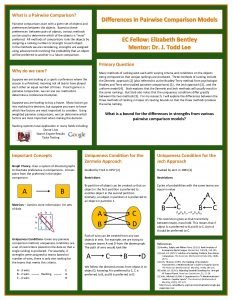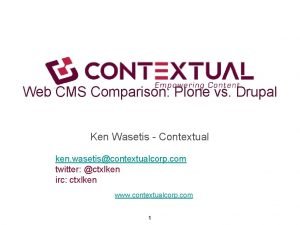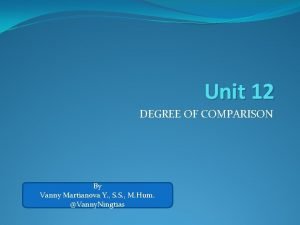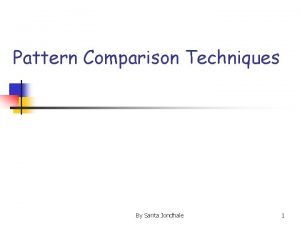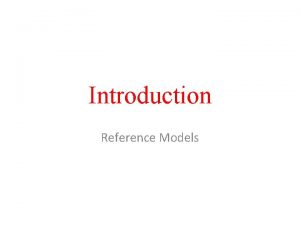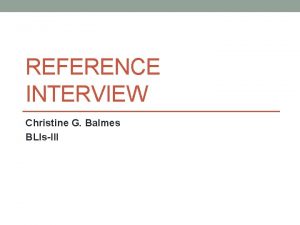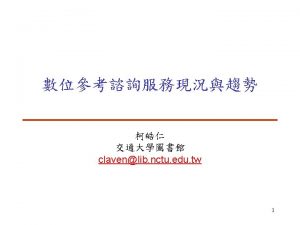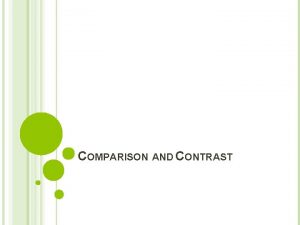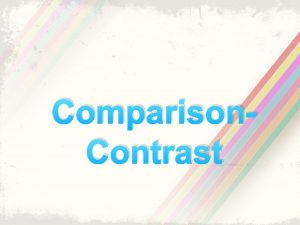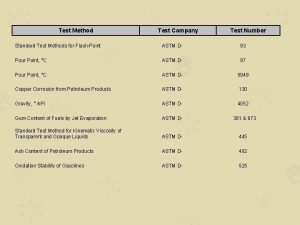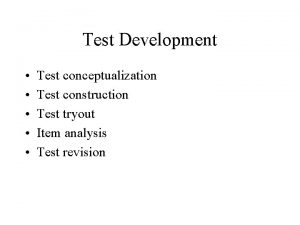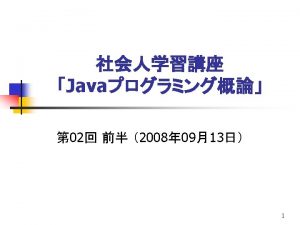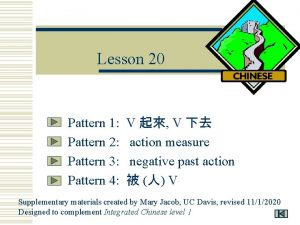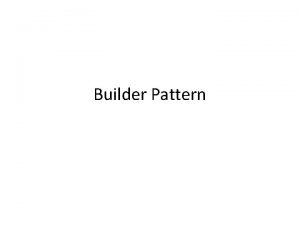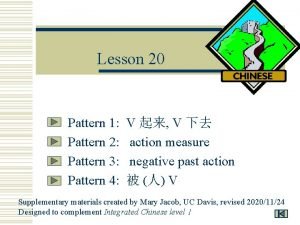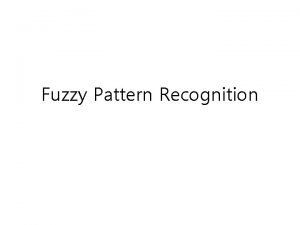PATTERN COMPARISON TECHNIQUES Test Pattern Reference Pattern 1
































































- Slides: 64

PATTERN COMPARISON TECHNIQUES Test Pattern: Reference Pattern: 1

4. 2 SPEECH (ENDPIONT) DETECTION 2

4. 3 DISTORTION MEASURESMATHEMATICAL CONSIDERATIONS x and y: two feature vectors defined on a vector space X The properties of metric or distance function d: A distance function is called invariant if 3

PERCEPTUAL CONSIDERATIONS Spectral changes that do not fundamentally change the perceived sound include: 4

PERCEPTUAL CONSIDERATIONS Spectral changes that lead to phonetically different sounds include: 5

PERCEPTUAL CONSIDERATIONS Just-discriminable change: known as JND (just-noticeable difference), DL (difference limen), or differential threshold 6

4. 4 DISTORTION MEASURESPERCEPTUAL CONSIDERATIONS 7

4. 4 DISTORTION MEASURESPERCEPTUAL CONSIDERATIONS 8

Spectral Distortion Measures Spectral Density Fourier Coefficients of Spectral Density Autocorrelation Function 9

Spectral Distortion Measures Short-term autocorrelation Then is an energy spectral density 10

Spectral Distortion Measures Autocorrelation matrices 11

Spectral Distortion Measures If σ/A(z) is the all-pole model for the speech spectrum, The residual energy resulting from “inverse filtering” the input signal with an all-zero filter A(z) is: 12

Spectral Distortion Measures Important properties of all-pole modeling: The recursive minimization relationship: 13

LOG SPECTRAL DISTANCE 14

LOG SPECTRAL DISTANCE 15

CEPSTRAL DISTANCES The complex cepstrum of a signal is defined as The Fourier transform of log of the signal spectrum. 16

CEPSTRAL DISTANCES Truncated cepstral distance 17

CEPSTRAL DISTANCES 18

CEPSTRAL DISTANCES 19

Weighted Cepstral Distances and Liftering It can be shown that under certain regular conditions, the cepstral coefficients, except c 0, have: 1) Zero means 2) Variances essentially inversed proportional to the square of the coefficient 3) index: If we normalize the cepstral distance by the variance inverse: 20

Weighted Cepstral Distances and Liftering Differentiating both sides of the Fourier series equation of spectrum: This is an L 2 distance based upon the differences between the spectral slopes 21

Cepstral Weighting or Liftering Procedure h is usually chosen as L/2 and L is typically 10 to 16 22

A useful form of weighted cepstral distance: 23

Likelihood Distortions Previously defined: Itakura-Saito distortion measure Where and of are one-step prediction errors and as defined: 24

25

Likelihood Distortions The residual energy can be easily evaluated by: 26

Likelihood Distortions By replacing by its optimal p-th order LPC model spectrum: If we set σ2 to match the residual energy α : Which is often referred to as Itakura distortion measure 27

Likelihood Distortions Another way to write the Itakura distortion measure is: Another gain-independent distortion measure is called the Likelihood Ratio distortion: 28

4. 5. 4 Likelihood Distortions 29

4. 5. 4 Likelihood Distortions That is, when the distortion is small, the Itakura distortion measure is not very different from the LR distortion measure 30

4. 5. 4 Likelihood Distortions 31

4. 5. 4 Likelihood Distortions Consider the Itakura-Saito distortion between the input and output of a linear system H(z) 32

4. 5. 4 Likelihood Distortions 33

4. 5. 4 Likelihood Distortions 34

4. 5. 5 Variations of Likelihood Distortions Symmetric distortion measures: 35

4. 5. 5 Variations of Likelihood Distortions COSH distortion 36

4. 5. 5 Variations of Likelihood Distortions 37

4. 5. 6 Spectral Distortion Using a Warped Frequency Scale Psychophysical studies have shown that human perception of the frequency Content of sounds does not follow a linear scale. This research has led to the idea of defining subjective pitch of pure tones. For each tone with an actual frequency, f, measured in Hz, a subjective pitch is measured on a scale called the “mel” scale. As a reference point, the pitch of a 1 k. Hz tone, 40 d. B above the perceptual hearing threshold, is defined as 1000 mels. 38

39

4. 5. 6 Spectral Distortion Using a Warped Frequency Scale 40

4. 5. 6 Spectral Distortion Using a Warped Frequency Scale 41

4. 5. 6 Spectral Distortion Using a Warped Frequency Scale 42

Examples of Critical bandwidth 43

Warped cepstral distance b is the frequency in Barks, S(θ(b)) is the spectrum on a Bark scale, and B is the Nyquist frequency in Barks. 44

4. 5. 6 Spectral Distortion Using a Warped Frequency Scale Where the warping function is defined by 45

4. 5. 6 Spectral Distortion Using a Warped Frequency Scale 46

4. 5. 6 Spectral Distortion Using a Warped Frequency Scale 47

4. 5. 6 Spectral Distortion Using a Warped Frequency Scale 48

4. 5. 6 Spectral Distortion Using a Warped Frequency Scale Mel-frequency cepstrum: is the output power of the triangular filters Mel-frequency cepstral distance 49

4. 5. 7 Alternative Spectral Representations and Distortion Measures 50

4. 5. 7 Alternative Spectral Representations and Distortion Measures 51

4. 5. 7 Alternative Spectral Representations and Distortion Measures 52

Summary of Spectral Distortion Measures Distortion Measure Notation Expression Computation 53

Summary of Spectral Distortion Measures Distortion Measure Notation Expression Computation 54

Summary of Spectral Distortion Measures Distortion Measure Notation Expression Computation 55

4. 6 INCORPORATION OF SPECTRAL DYNAMIC FEATURES INTO THE DISTORTION MEASURE 56

4. 6 INCORPORATION OF SPECTRAL DYNAMIC FEATURES INTO THE DISTORTION MEASURE Fitting the cepstral trajectory by a second order polynomial, Choose h 1, h 2, h 3 such that E is minimized. Differentiating E with respect to h 1, h 2, and h 3 and setting to zero results in 3 equations: 57

4. 6 INCORPORATION OF SPECTRAL DYNAMIC FEATURES INTO THE DISTORTION MEASURE The solutions to these equations are: 58

4. 6 INCORPORATION OF SPECTRAL DYNAMIC FEATURES INTO THE DISTORTION MEASURE 59

4. 6 INCORPORATION OF SPECTRAL DYNAMIC FEATURES INTO THE DISTORTION MEASURE 60

4. 6 INCORPORATION OF SPECTRAL DYNAMIC FEATURES INTO THE DISTORTION MEASURE A differential spectral distance: A second differential spectral distance: 61

4. 6 INCORPORATION OF SPECTRAL DYNAMIC FEATURES INTO THE DISTORTION MEASURE Cepstral weighting or liftering by differentiating 62

4. 6 INCORPORATION OF SPECTRAL DYNAMIC FEATURES INTO THE DISTORTION MEASURE A weighted differential cepstral distance: 63

4. 6 INCORPORATION OF SPECTRAL DYNAMIC FEATURES INTO THE DISTORTION MEASURE Taking the L 2 distance as an example: 64
 Limit comparison theorem
Limit comparison theorem Reference node and non reference node
Reference node and non reference node Reference node and non reference node
Reference node and non reference node Poetic devices comparison
Poetic devices comparison Fonctions techniques et solutions techniques
Fonctions techniques et solutions techniques Pattern of development classification example
Pattern of development classification example Pattern of development used
Pattern of development used Pattern comparison
Pattern comparison Comparison test
Comparison test Uji post hoc adalah
Uji post hoc adalah Visual comparison test
Visual comparison test Direct comparison test
Direct comparison test Four grid reference
Four grid reference What are the two methods of transferring marks on fabric
What are the two methods of transferring marks on fabric Relaxation techniques test anxiety
Relaxation techniques test anxiety Specification based testing techniques
Specification based testing techniques A test design technique is
A test design technique is Test techniques foundation
Test techniques foundation Separation techniques quiz
Separation techniques quiz Fingerprint minutiae types
Fingerprint minutiae types Pattern and pattern classes in image processing
Pattern and pattern classes in image processing L
L Frequent pattern
Frequent pattern Aspect ratio test
Aspect ratio test Gamma pattern
Gamma pattern Advantages of criterion-referenced assessment
Advantages of criterion-referenced assessment Www.123 test.com/disc-personality-test/
Www.123 test.com/disc-personality-test/ Heterophoria vs heterotropia
Heterophoria vs heterotropia Esophoria
Esophoria One proportion z test
One proportion z test Z test table
Z test table Univariate analysis tests
Univariate analysis tests Paired vs unpaired t test
Paired vs unpaired t test Butcher test formula
Butcher test formula When do we use z test or t test
When do we use z test or t test Parametric and nonparametric tests
Parametric and nonparametric tests Forced duction test procedure
Forced duction test procedure Yansız atama nedir
Yansız atama nedir 123 test.com/career-test
123 test.com/career-test When to use z test and t test
When to use z test and t test Www.123 test.com/disc-personality-test/
Www.123 test.com/disc-personality-test/ Achievement test and aptitude test
Achievement test and aptitude test Practice test 1 science reasoning test
Practice test 1 science reasoning test Unit test algebra 2
Unit test algebra 2 123 test.com/career-test
123 test.com/career-test Mann-whitney u test vs t-test
Mann-whitney u test vs t-test Curl up score example
Curl up score example Tek denekli desenler
Tek denekli desenler Extends testcase
Extends testcase 123 test.com/career-test
123 test.com/career-test Uji t
Uji t Test plan vs test strategy
Test plan vs test strategy Dolaxin
Dolaxin Nsa mathematics proficiency test practice test
Nsa mathematics proficiency test practice test Block organization essay
Block organization essay Comparison and contrast paragraph
Comparison and contrast paragraph Pairwise comparison
Pairwise comparison How does level 16 end
How does level 16 end Web cms comparison
Web cms comparison Conservancy system
Conservancy system Comparison context clue
Comparison context clue Datagram network and virtual circuit network
Datagram network and virtual circuit network Romeo and juliet vs west side story venn diagram
Romeo and juliet vs west side story venn diagram The cheetah is the fastest animal positive degree
The cheetah is the fastest animal positive degree Adjectives er/more the eat/the most
Adjectives er/more the eat/the most





